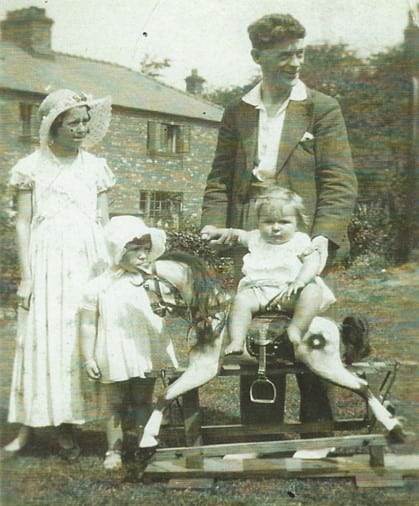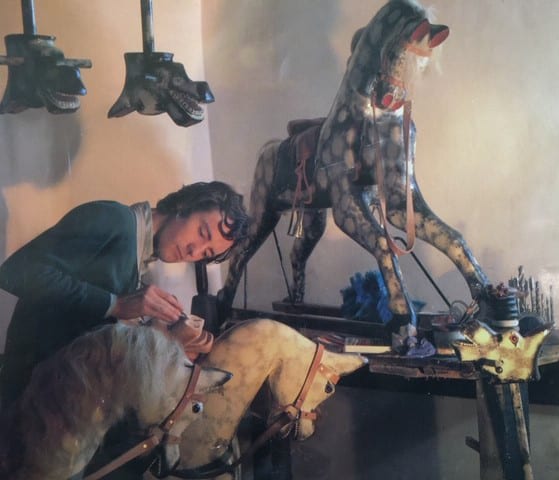Blog
Preserving the art of rocking horse making with the rebirth of Mr Hignett’s Horses
5 September 2020
I made my first rocking horse at the age of 11 under the guidance of my father, who learnt the trade from his own father, Richard Hignett.
Richard began making toys in the late 1890s, setting himself up as a a 'wood toy maker' between 1899 and 1901. Operating out of his home workshop in Liverpool, Richard soon sold his his rocking horses to individual customers and larger clients, including the famous Blackler's department store He also sold horses to the White Star Line and Cunard Lines cruise companies, where they furnished the playrooms of the Titanic, the Lusitania and other great ships.
Here is a picture of one of Richard's horses taken in 1933. It has Uncle Alf, Auntie Josie and my cousins Margaret and Dorothy on the horse. Josie was the best at decorating the horses and I try to use her pattern - which you can see on this horse - on my own horses today.

In those days the whole family were involved in making the horses, at least when they were not at school or doing homework. There were six children involved, Alfred, George, Thomas, John, James and the youngest, Josephine. Many family stories were passed down to the next generation about grandad Richard's rocking horse business and it was often suggested that someone should “re-start the rocking horses”. I was quite a practical child and they didn’t really know what to do with me at school. I could do Scientific subjects well, but I was also good a metal work and woodwork - though a messy technical drawer.
So, my school (John Hamilton High School for Boys, in Liverpool), encouraged me to keep up my technical studies to “O” level then just do science stuff at “A” level. I loved the colours and flames of chemistry so carried on with that, but I found Biology a bit too easy, as in those days you just seem to have to remember the text book. I carried on with Chemistry at College as you never know it might come in handy. I scraped through Physics, but my maths wasn’t hot. I found that I could do it quite well later, I mustn’t have been paying attention. So, after studying Chemistry and Biology at university in the 1980's I set up the new company "Mr Hignett's Horses" and operated out of the Gladstone Pottery Museum in Longton Stoke on Trent. Here is me in the 80’s. Some say I haven’t changed, though I have less hair and am more grizzled now.

I had been working in the museum as a scientific cataloguer. I quite liked the Museum as it was full of old furniture and scientific apparatus which reminded me of how beautiful old instruments were, with polished brass and rare hardwood fittings. Today they are generally just white or grey functional boxes. We seemed to be in a permanent recession in the 80's, so it was a tough time to be setting up a business. After about 18 months, and with the arrival of my first son, Richard, I decided to move into teaching. But even then, had plans to re-build the business when finances permitted.
Thirty years later and after leaving teaching for a long stint in the pharmaceutical industry, I decided to retire early and try again.
The aim of the new Mr Hignett's Horses is to build beautiful rocking horses which will provide children and adults with fun for many years. They are, in my opinion both “useful and beautiful”, as William Morris’ would say. I want to continue to make them by hand as much as possible, only resorting to power tools when large amounts of material need to be removed. You will find some 'makers marks' on each horse, which I have not removed from the materials as one day it will help tell the story of how the horse was made. This is rare today given the prevalence of cheaper, automated approaches to carving.
Here is the brochure I used for my old business. And here is a picture of me and some of my horses in 1984. I have continued to make rocking horses ever since I was 11. I believe each one is stunning to look at and hardwearing enough to last a lifetime or more. and each one is I think stunning to look at and hardwearing enough to last a lifetime or more. I continually strive to improve the horses, either by simplifying the process, improving my carving skills or discovering and utilising better materials. I decided to retire in 2018 and spent a lot of time planning and sourcing materials. My current horses are the finest I have ever made.

I use poplar - sometimes called tulipwood - for the horse and ash for the stand. The Poplar is a hard wood but it is reasonably easy to carve with sharp tools. The ash is perfect for the stands as it is very hard and has a beautiful grain. Sadly it is increasing in price and I expect that this is due to the fungus Hymenoscyphus fraxineus (previously known as Chalara fraxinea). I do worry that we will have no Ash to work with some day.
So I suppose I am trying to go back to what I really like doing - making things. I have had fun with the gesso we use, all of which has been tested to EN71 to make sure that they are safe for children’s toys. I am looking into tanning horse hides at the moment in a way that will ensure they have long lives and, again, are safe for children. Much leather nowadays is tanned using chromium salts, which produce excellent results but which quite toxic. The best leather is made by vegetable tanning and that is also safe for children but it can take up to 7 months. So I am experimenting with oxalic acid at the moment.
Essentially, I am doing what I have always loved doing, making beautiful things, and playing around with chemistry. Joy!

